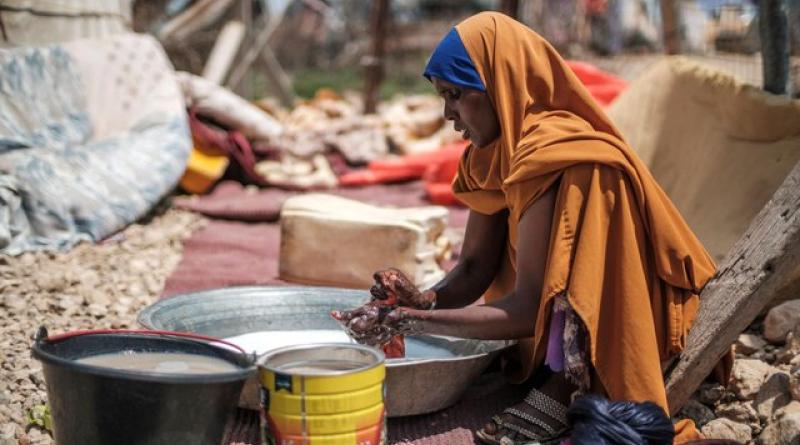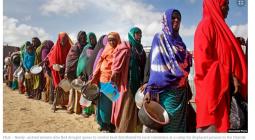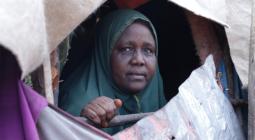Drought in Somalia is set to leave millions of people without enough food.

Months after world leaders gathered in Glasgow for what many experts billed as our last best chance to fend off the worst effects of a warming planet, the devastating reality of climate change is being felt by millions of people in Somalia, a country more than 6,000 miles away from Scotland, where people are suffering through the worst drought in a generation.
Here along Africa' s eastern edge, multiple crises have conspired to create a dire humanitarian emergency – political instability; recurrent climate shocks; decades of conflict resulting in large-scale displacement of people; the impacts of the Covid pandemic; and a prolonged desert locust infestation that has affected crop yields, harvests, and pasture.
While it may be impossible to draw a ‘cause and effect’ relationship between climate change and any specific weather event, there can be little doubt that the current unprecedented drought has been fuelled by broader climatic change.
Consider that, in an average year along Somalia's northern and northeast coasts, rainfall measures in the range of just 50 to 300 millimetres – most years, Edinburgh, by comparison, receives some 800mm of rain.
But after three straight failed rainy seasons, nearly 90 per cent of Somalia is experiencing a severe drought. A fourth consecutive failed rainy season, which now appears likely, would result in a drought that rivals the worst of the past decade. And in fact, some areas are facing their driest season in four decades.
For an economy that mainly relies on farming and livestock, the resulting devastation is widespread. So much so that the United Nations believes that by May of this year, 4.6 million Somalis – approximately 30 per cent of the country's population – will be without enough food, and an estimated 7.7 million Somalis will need some form of humanitarian assistance.
Approximately 1.2 million children under the age of five are likely to be acutely malnourished by May, including more than 200,000 whose condition will reach life-threatening levels if treatment is not provided immediately.
In the hardest hit areas, the level of anguish is already harrowing. Many families have lost everything, and farmers have taken their herds hundreds of kilometres in a desperate bid to find pasture.
The few animals that survive these journeys are left to feed on cactus and other plants that can be toxic to livestock.
In Lower Juba, I recently met women who had left their husbands behind to watch over their depleted herds. These women and their children were living in makeshift shelters on the outskirts of nearby towns with no food and no access to water and sanitation. They face an ongoing scramble for survival.
As bad as things are now, the coming months promise to be even harsher for the Somali people as the drought continues and supplies of food and water dwindle. However, the suffering can be alleviated if the international community acts quickly to save lives and protect livelihoods.
My organisation, Mercy Corps, has worked in Somalia since 2005, and today we are providing emergency cash and food to the families who are most affected by drought. We are also trucking in emergency water supplies to remote villages for the communities and their livestock. Last year, we reached over 700,000 people with emergency assistance.
Still, much more is needed to avert mass starvation and death. The United Nations-led humanitarian response plan for this year seeks close to US$1.5 billion to assist 5.5 million of the most vulnerable Somalis. Last year’s appeal of $1.09 billion was only 71 per cent funded.
While we must save lives and stop the situation from getting worse, in this age of constant crisis, emergency response efforts must also support communities to recover and withstand future shocks. This includes building local markets to increase the pace and scale of economic recovery.
While providing essentials like food and water when none are available is necessary, local businesses that know their communities and customers best are also often the quickest to adapt to meet people's needs.
They can work through local networks and obtain access in ways that aid agencies sometimes cannot, and we see that they often get back and up running quickly.
That is why, when markets are functioning, transitioning to providing emergency cash – rather than food – is critical, as it not only enables people to purchase what they need most but also helps keep local economies going.
Emergency financial and technical support from organisations like Mercy Corps can be a critical lifeline to help local businesses survive and become stronger to withstand future shocks. These markets serve as vital drivers of recovery and growth and are a sustainable way of addressing poverty.
Without question, the humanitarian crisis in Somalia is among the most challenging and complex on the planet. And although it will not be easily solved, it can be ameliorated with focused international attention and marshalling of resources to help Somalis survive the looming drought while building their ability to cope with ongoing and future crises.
Here in Somalia, we are seeing first-hand what happens when little is done to protect the planet from a changing climate. If we have so far proven unable to protect the planet itself, the coming months in Somalia will show if we are more capable and willing to come together to protect its most vulnerable people.
Daud Jiran is the country director for Somalia for Mercy Corps, an international aid organisation
cover photo: Amid a severe drought affecting much of the Horn of Africa, women and children are living in makeshift shelters (Picture: Eduardo Soteras/AFP via Getty Images)






